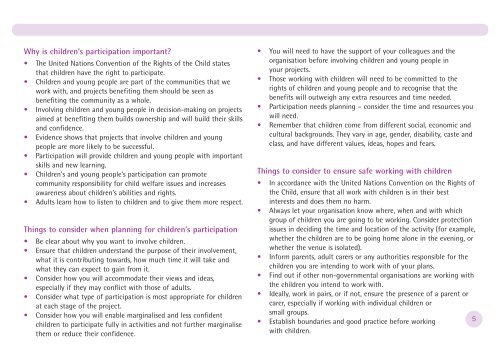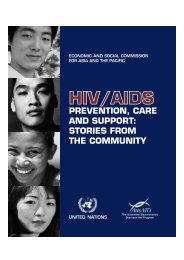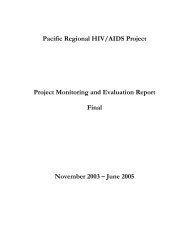A Parrot on your Shoulder â A guide for people ... - hivpolicy.org
A Parrot on your Shoulder â A guide for people ... - hivpolicy.org
A Parrot on your Shoulder â A guide for people ... - hivpolicy.org
You also want an ePaper? Increase the reach of your titles
YUMPU automatically turns print PDFs into web optimized ePapers that Google loves.
Why is children’s participati<strong>on</strong> important?<br />
• The United Nati<strong>on</strong>s C<strong>on</strong>venti<strong>on</strong> of the Rights of the Child states<br />
that children have the right to participate.<br />
• Children and young <strong>people</strong> are part of the communities that we<br />
work with, and projects benefiting them should be seen as<br />
benefiting the community as a whole.<br />
• Involving children and young <strong>people</strong> in decisi<strong>on</strong>-making <strong>on</strong> projects<br />
aimed at benefiting them builds ownership and will build their skills<br />
and c<strong>on</strong>fidence.<br />
• Evidence shows that projects that involve children and young<br />
<strong>people</strong> are more likely to be successful.<br />
• Participati<strong>on</strong> will provide children and young <strong>people</strong> with important<br />
skills and new learning.<br />
• Children's and young <strong>people</strong>’s participati<strong>on</strong> can promote<br />
community resp<strong>on</strong>sibility <strong>for</strong> child welfare issues and increases<br />
awareness about children’s abilities and rights.<br />
• Adults learn how to listen to children and to give them more respect.<br />
Things to c<strong>on</strong>sider when planning <strong>for</strong> children’s participati<strong>on</strong><br />
• Be clear about why you want to involve children.<br />
• Ensure that children understand the purpose of their involvement,<br />
what it is c<strong>on</strong>tributing towards, how much time it will take and<br />
what they can expect to gain from it.<br />
• C<strong>on</strong>sider how you will accommodate their views and ideas,<br />
especially if they may c<strong>on</strong>flict with those of adults.<br />
• C<strong>on</strong>sider what type of participati<strong>on</strong> is most appropriate <strong>for</strong> children<br />
at each stage of the project.<br />
• C<strong>on</strong>sider how you will enable marginalised and less c<strong>on</strong>fident<br />
children to participate fully in activities and not further marginalise<br />
them or reduce their c<strong>on</strong>fidence.<br />
• You will need to have the support of <strong>your</strong> colleagues and the<br />
<strong>org</strong>anisati<strong>on</strong> be<strong>for</strong>e involving children and young <strong>people</strong> in<br />
<strong>your</strong> projects.<br />
• Those working with children will need to be committed to the<br />
rights of children and young <strong>people</strong> and to recognise that the<br />
benefits will outweigh any extra resources and time needed.<br />
• Participati<strong>on</strong> needs planning – c<strong>on</strong>sider the time and resources you<br />
will need.<br />
• Remember that children come from different social, ec<strong>on</strong>omic and<br />
cultural backgrounds. They vary in age, gender, disability, caste and<br />
class, and have different values, ideas, hopes and fears.<br />
Things to c<strong>on</strong>sider to ensure safe working with children<br />
• In accordance with the United Nati<strong>on</strong>s C<strong>on</strong>venti<strong>on</strong> <strong>on</strong> the Rights of<br />
the Child, ensure that all work with children is in their best<br />
interests and does them no harm.<br />
• Always let <strong>your</strong> <strong>org</strong>anisati<strong>on</strong> know where, when and with which<br />
group of children you are going to be working. C<strong>on</strong>sider protecti<strong>on</strong><br />
issues in deciding the time and locati<strong>on</strong> of the activity (<strong>for</strong> example,<br />
whether the children are to be going home al<strong>on</strong>e in the evening, or<br />
whether the venue is isolated).<br />
• In<strong>for</strong>m parents, adult carers or any authorities resp<strong>on</strong>sible <strong>for</strong> the<br />
children you are intending to work with of <strong>your</strong> plans.<br />
• Find out if other n<strong>on</strong>-governmental <strong>org</strong>anisati<strong>on</strong>s are working with<br />
the children you intend to work with.<br />
• Ideally, work in pairs, or if not, ensure the presence of a parent or<br />
carer, especially if working with individual children or<br />
small groups.<br />
• Establish boundaries and good practice be<strong>for</strong>e working<br />
with children.<br />
5











